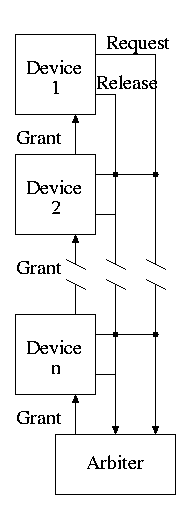======== START LECTURE #26
========
Improving Bus Performance
These improvements mostly come at the cost of increased expense and/or
complexity.
- Hierarchy of buses.
- Synchronous instead of asynchronous protocols.
- Synchronous is actually simplier, but it essentially implies a
hierarchy of protocols since not all devices can operate at the
same speed.
- Wider data path: Use more wires, send more at once.
- Separate address and data lines: Same as above.
- Block transfers: Permit a single transaction to transfer more than
one busload of data. Saves the time to release and acquire the bus,
but the protocol is more complex.

- Obtaining bus access:
- The simplest scheme is to permit only one bus
master.
- That is on each bus only one device is permited to
initiate a bus transaction.
- The other devices are slaves that only
respond to requests.
- With a single master, there is no issue of arbitrating
among multiple requests.
- One can have multiple masters with daisy
chaining of the grant line.
- Any device can raise the request line.
- The device with the request raises the release line when
done.
- The arbiter monitors the request and request lines and
raises the grant line.
- The grant signal is passed from one to the other so the
devices near the arbiter have priority and can starve the ones
further away.
- Passing the grant from device to device takes time.
- Simple but not fair or high performance
- Centralized parallel arbiter: Separate request lines from each
device and separate grant lines. The arbiter decides which device
should be granted the bus.
- Distributed arbitration by self-selection: Requesting
processes identify themselves on the bus and decide individually
(and consistently) which one get the grant.
- Distributed arbitration by collision detection: Each device
transmits whenever it wants, but detects collisions and retries.
Ethernet uses this scheme (but not new switched ethernets).
| Option | High performance | Low cost |
|---|
| bus width | separate address and data lines |
multiplex address and data lines |
| data width | wide | narrow |
| transfer size | multiple bus loads | single bus loads |
| bus masters | multiple | single |
| clocking | synchronous | asynchronous |
Do on the board the example on pages 665-666
